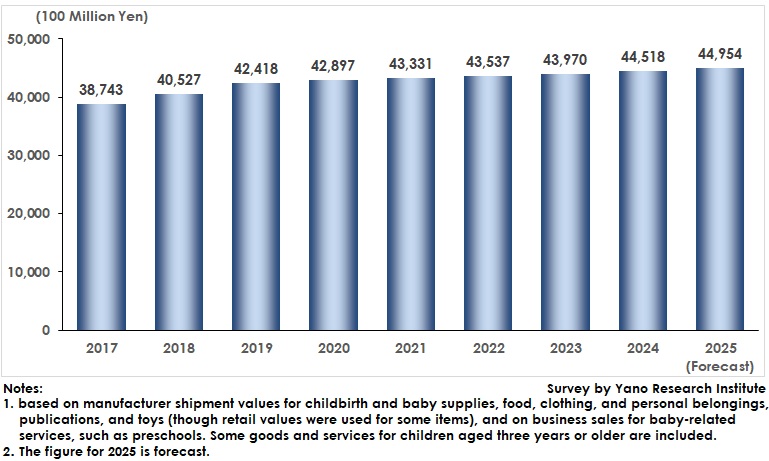No.3786
Baby-Related Business Market in Japan: Key Research Findings 2025
Domestic Baby-Related Business Market in 2024 Rose by 1.2% from Previous Year to Reach 4,451.8 Billion Yen
Yano Research Institute (the President, Takashi Mizukoshi) has conducted a survey on the domestic baby-related business market and found out the market trendy by baby goods and service the trends of market players, and market prospects.

Market Overview
The baby-related business market is estimated at 4,353.7 billion yen in 2024, which is a 1.2% increase from the previous year. This growth was supported by the robust preschool market, despite a shrinking demander population due to a decline in births.
By category, in addition to baby-related services (preschools), food, clothing, publications, and toys increased from the previous year, while childbirth and baby supplies decreased. The increases in food, clothing, publications, and toys were due to price adjustments. This price escalation offset the decrease in sales volume resulting from the shrinking demander population.
Noteworthy Topics
Trend of Food Demand (Baby Formula and Food)
The baby formula market has maintained stable growth in 2024, because of an increasing number of dual-income households seeking to alleviate childrearing burdens, changing attitudes toward breastfeeding and formula use, and heightened awareness of the convenience of baby formula. The market has also been boosted by price revisions from each manufacturer, as well as increased opportunities to use baby formula, as more fathers are taking childcare leave.
The baby food market has been on an expanding trend for the past few years, because of increased demand for quicker and simpler methods of preparing weaning food, and waning guilt about using processed food for babies. However, the market downturned in 2024, as the effects from price revisions expired, a major manufacturer discontinued products (end of sales), consumers became hesitant to purchase due to rising commodity prices, and people minimized outings due to extreme heat.
Nevertheless, demand for baby food remains robust, as more mothers are expected to enter the workforce and more fathers are expected to take childcare leave, and manufacturers continue their product promotions. Still, some concerns remain, such as the possibility that rising material costs could reduce product variety.
Future Outlook
The baby-related business market remains uncertain about its ability to grow considerably because of the significant impact of declining birth rates and child populations. While the market is expected to grow slightly, supported by infant services such as preschools, continued decreases in births could lead to a more severe market environment. Therefore, market players must strive to minimize the influence of shrinking domestic demand by obtaining demand from overseas and developing and launching value-added products.
The preschool market, which has been supporting the baby-related business market for the past few years, remains stable due to continued public funding to support child rearing and to combat diminishing births, despite slower market growth due to a slower pace of new establishment openings and fewer enrolled infants. However, the preschool market could also stall if preschool operators experience a further decrease in enrollment, a shakeout among preschools, or withdrawal from business.
Research Outline
2.Research Object: Baby, maternity, and childcare support related businesses
3.Research Methogology: Face-to-face interviews (including online) by expert researchers, survey via telephone and email, and literature research
The Baby-Related Business Market
This research focuses on the market for goods and services related to childbirth and infants aged 0–2. Market size was calculated based on manufacturer shipment values for childbirth and baby supplies, food, clothing, and personal belongings, publications, and toys (though retail values were used for some items), and on business sales for baby-related services, such as preschools. Please note that some goods and services for children aged three years or older are included.
<Products and Services in the Market>
Products for giving birth and raising children (feeding bottles, infant nipples, baby tableware, baby diapers, skincare products, baby beds and bedding, prams/strollers, baby chairs & racks, child safety seats, and baby carriers), food (baby formula and baby food), clothing (baby clothing, shoes, and maternity clothing), publications & toys (magazines about raising babies, picture books, intellectual culture books, intellectual training toys, toys for toddlers), infants related services (preschools)
Published Report
Contact Us
The copyright and all other rights pertaining to this report belong to Yano Research Institute.
Please contact our PR team when quoting the report contents for the purpose other than media coverage.
Depending on the purpose of using our report, we may ask you to present your sentences for confirmation beforehand.